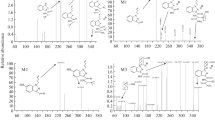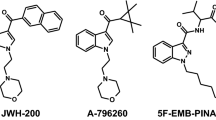Abstract
In order to address the increasing abuse of synthetic cannabinoids, on July 1, 2021, China listed the whole category of synthetic cannabinoids in the Supplementary Catalog for the Control of Non-medicinal Narcotic Drugs and Psychotropic Substances. Because synthetic cannabinoids metabolize rapidly, techniques are urgently needed to identify the phase I metabolites of new synthetic cannabinoids, as well as the symbol metabolites, which can be used for detection in real cases. In this study, we used pooled human liver microsome (pHLM) and zebrafish combined with ultra-high-performance liquid chromatography (UHPLC) Q Exactive Orbitrap MS to identify the phase I metabolites of two new synthetic cannabinoids 4F-MDMB-BICA and 4F-MDMB-BINACA in vitro and in vivo, respectively. We studied the toxicokinetics of 4F-MDMB-BICA and 4F-MDMB-BINACA by sampling from a pHLM incubation system at different time points to study the change in metabolites over time. We detected a total of 14 metabolites of 4F-MDMB-BINACA and 16 metabolites of 4F-MDMB-BICA in this study. Metabolites of 4F-MDMB-BICA were detected in vitro for the first time. One metabolite of 4F-MDMB-BINACA, M05, was discovered for the first time. Based on the toxicokinetics results, we recommend three metabolites (M03, M11, M12) of 4F-MDMB-BINACA and three metabolites (M10, M12, M14) of 4F-MDMB-BICA as their symbol metabolites. The results showed that these two structurally similar synthetic cannabinoids 4F-MDMB-BINACA and 4F-MDMB-BICA had similar metabolic processes, as well as similar structures of their main symbol metabolites.








Similar content being viewed by others
Data availability
Not applicable.
Code availability
Not applicable.
References
Winstock AR, Barratt MJ. Synthetic cannabis: A comparison of patterns of use and effect profile with natural cannabis in a large global sample. Drug Alcohol Depend. 2013;131(1-2):106–11. https://doi.org/10.1016/j.drugalcdep.2012.12.011.
Trecki J, Gerona RR, Schwartz MD. Synthetic Cannabinoid-Related Illnesses and Deaths. N Engl J Med. 2015;373(2):103–7. https://doi.org/10.1056/NEJMp1505328.
van Jan AJ, Brunt T, van den Brink W. The adverse health effects of synthetic cannabinoids with emphasis on psychosis-like effects. J Psychopharmacol. 2015;29(3):254–63. https://doi.org/10.1177/0269881114565142.
Bileck A, Ferk F, Al-Serori H, Koller VJ, Muqaku B, Haslberger A, et al. Impact of a synthetic cannabinoid (CP-47,497-C8) on protein expression in human cells: evidence for induction of inflammation and DNA damage. Arch Toxicol. 2016;90(6):1369–82. https://doi.org/10.1007/s00204-015-1569-7.
Guler EM, Bektay MY, Akyildiz AG, Sisman BH, Izzettin FV, Kocyigit A. Investigation of DNA damage, oxidative stress, and inflammation in synthetic cannabinoid users. Hum Exp Toxicol. 2020;39(11):1454–62. https://doi.org/10.1177/0960327120930057.
Silva JP, Carmo H, Carvalho F. In vitro nephrotoxicity of synthetic cannabinoids. Toxicol Lett. 2017;208:S137. https://doi.org/10.1016/j.toxlet.2017.07.384.
World Health Organization. Critical Review Report: 4F-MDMB-BINACA. Geneva: Expert Committee on Drug Dependence; 2019, Oct 21-25.
Krotulski AJ, Mohr ALA, Kacinko SL, Fogarty MF, Shuda SA, Diamond FX, et al. 4F-MDMB-BINACA: A New Synthetic Cannabinoid Widely Implicated in Forensic Casework. J Forensic Sci. 2019;64(5):1451–61. https://doi.org/10.1111/1556-4029.14101.
Haschimi B, Mogler L, Halter S, Giorgetti A, Schwarze B, Westphal F, et al. Detection of the recently emerged synthetic cannabinoid 4F- MDMB-BINACA in “legal high” products and human urine specimens. Drug Test Anal. 2019. https://doi.org/10.1002/dta.2666.
Leong HS, Watanabe S, Kuzhiumparambil U, Fong CY, Moy HY, Yao YJ, et al. Monitoring metabolism of synthetic cannabinoid 4F-MDMB-BINACA via high-resolution mass spectrometry assessed in cultured hepatoma cell line, fungus, liver microsomes and confirmed using urine samples. Forensic Toxicol. 2021;39(1):198–212. https://doi.org/10.1007/s11419-020-00562-7.
EMCDDA. EMCDDA initial report on the new psychoactive substance 4F-MDMB-BICA. Initial reports. Luxembourg: Publications Office of the European Union; 2020.
Cannaert A, Sparkes E, Pike E, Luo JL, Fang AD, Kevin RC, et al. Synthesis and in Vitro Cannabinoid Receptor 1 Activity of Recently Detected Synthetic Cannabinoids 4F-MDMB-BICA, 5F-MPP-PICA, MMB-4en-PICA, CUMYL-CBMICA, ADB-BINACA, APP-BINACA, 4F-MDMB-BINACA, MDMB-4en-PINACA, A-CHMINACA, 5F-AB-P7AICA, 5F-MDMB-P7AICA, and 5F-AP7AICA. ACS Chem Neurosci. 2020;11(24):4434–46. https://doi.org/10.1021/acschemneuro.0c00644.
Chen XR. The whole range of synthetic cannabinoids will be legally controlled in China on July 1, China has become the first country in the world to legally controlled the whole range of synthetic cannabinoid. Beijing: The Ministry of Public Security of the People’s Republic of China; 2021. Available from: https://www.mps.gov.cn/n2254098/n4904352/c7880396/content.html
Szultka-Mlynska M, Buszewski B. Study of in-vitro metabolism of selected antibiotic drugs in human liver microsomes by liquid chromatography coupled with tandem mass spectrometry. Anal Bioanal Chem. 2016;408(29):8273–87. https://doi.org/10.1007/s00216-016-9929-6.
Gaunitz F, Dahm P, Mogler L, Thomas A, Thevis M, Mercer-Chalmers-Bender K. In vitro metabolic profiling of synthetic cannabinoids by pooled human liver microsomes, cytochrome P450 isoenzymes, and Cunninghamella elegans and their detection in urine samples. Anal Bioanal Chem. 2019;411(16):3561–79. https://doi.org/10.1007/s00216-019-01837-8.
Takayama T, Suzuki M, Todoroki K, Inoue K, Min JZ, Kikura-Hanajiri R. UPLC/ESI-MS/MS-based determination of metabolism of several new illicit drugs, ADB-FUBINACA, AB-FUBINACA, AB-PINACA, QUPIC, 5F-QUPIC and α-PVT, by human liver microsome. Biomed Chromatogr. 2014;28(6):831–8. https://doi.org/10.1002/bmc.3155.
Apirakkan O, Gavrilovic I, Cowan DA, Abbate V. In Vitro Phase I Metabolic Profiling of the Synthetic Cannabinoids AM-694, 5F-NNEI, FUB-APINACA, MFUBINAC, and AMB-FUBINACA. Chem Res Toxicol. 2020;33(7):1653-1664. https://doi.org/10.1021/acs.chemrestox.9b00466.
Kong TY, Kim JH, Choi WG, Lee JY, Kim HS, Kim JY, et al. Metabolic characterization of (1-(5-fluoropentyl)-1H-indol-3-yl) (4-methyl-1-naphthalenyl)-methanone (MAM-2201) using human liver microsomes and cDNA-overexpressed cytochrome P450 enzymes. Anal Bioanal Chem. 2017;409(6):1667–80. https://doi.org/10.1007/s00216-016-0113-9.
Mogler L, Franz F, Rentsch D, Angerer V, Weinfurtner G, Longworth M, et al. Detection of the recently emerged synthetic cannabinoid 5F-MDMB-PICA in legal high products and human urine samples. Drug Test Anal. 2018;10(1):196–205. https://doi.org/10.1002/dta.2201.
Watanabe S, Vikingsson S, Astrand A, Green H, Kronstrand R. Biotransformation of the New Synthetic Cannabinoid with an Alkene, MDMB-4en-PINACA, by Human Hepatocytes, Human Liver Microsomes, and Human Urine and Blood. Aaps J. 2019;22(1):9. https://doi.org/10.1208/s12248-019-0381-3.
Nishimura Y, Inoue A, Sasagawa S, Koiwa J, Kawaguchi K, Kawase R, et al. Using zebrafish in systems toxicology for developmental toxicity testing. Congenit Anom. 2016;56(1):18–27. https://doi.org/10.1111/cga.12142.
Author information
Authors and Affiliations
Contributions
Not applicable.
Corresponding authors
Ethics declarations
Ethics approval
Zebrafish experiments were conducted in accordance with the regulations of the Guide for Care and Use of Laboratory Animals and were approved by the Ethics Committee of the Institute of Forensic Science Ministry of Public Security (2021-031).
Consent to participate
Not applicable.
Consent for publication
Not applicable.
Additional declarations for articles in life science journals that report the results of studies involving humans and/or animals
Not applicable.
Conflicts of interest/Competing interests
The authors declare that they have no conflicts of interest or competing interests in this paper.
Additional information
Publisher’s note
Springer Nature remains neutral with regard to jurisdictional claims in published maps and institutional affiliations.
Rights and permissions
About this article
Cite this article
Li, H., Qian, Z., Zhao, Y. et al. Study on the metabolic process of synthetic cannabinoids 4F-MDMB-BINACA and 4F-MDMB-BICA in human liver microsome and zebrafish model via UHPLC-QE Orbitrap MS. Anal Bioanal Chem 414, 3905–3916 (2022). https://doi.org/10.1007/s00216-022-04034-2
Received:
Revised:
Accepted:
Published:
Issue Date:
DOI: https://doi.org/10.1007/s00216-022-04034-2




